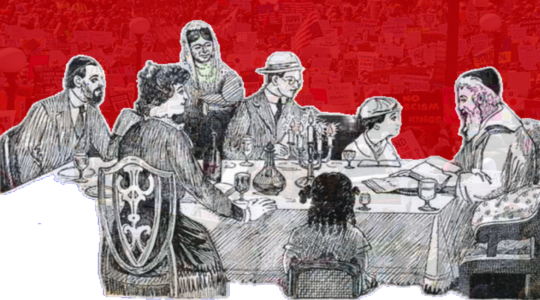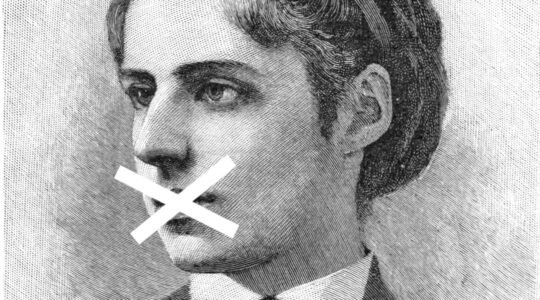A few weeks ago, on a blazing hot Sunday afternoon in Rome, my wife and I visited the Arch of Titus, the first-century structure associated with tragedy in Jewish history. It was built in 81 CE in honor of Titus, the Roman emperor who viciously put down a Jewish rebellion, leading to the destruction of the Second Temple in Jerusalem in the year 70.
We felt especially moved to be there on the 17th of Tammuz, a fast day that marks the breach of the walls of the Second Temple in Jerusalem, initiating the siege that led to widespread death and destruction among the Jews, and the fall of the holy site three weeks later on Tisha b’Av (the 9th of Av), which is observed on Saturday night and Sunday this weekend.
Most poignant was witnessing the famous carvings on the arch marking the triumphal procession of the Roman soldiers, carrying off the spoils of war, including sacred items from the Temple. The largest shown is the menorah, carved in deep relief.
One shudders to imagine the scene depicted on the arch, showing some of the estimated 200,000 Jews who were captured in Jerusalem and brought to Rome to be sold into slavery, as they were being marched past hostile, taunting crowds.
Our guide noted that many years ago the chief rabbi of Rome banned Jews from walking under the arch, a policy that was rescinded, dramatically, in May 1948, when the State of Israel was declared. At that time local Jews gathered at the arch to march, symbolically, in the opposite direction of those shown in the carving — toward Jerusalem rather than away from the holy city.
It was another reminder to us, near the end of our two-week visit to Italy, of the deep, though sometimes tragic, history of the country’s Jewish community. It is one that dates back some 2,200 years, to the days of the Maccabees, and underscores the connection Jews throughout the diaspora have had to Jerusalem.
As we proceeded on our walking tour that day, we visited the nearby Colosseum, the most dramatic and popular symbol of the Roman Empire, completed in the year 80 by Titus, and “financed with the spoils of the Jewish War of 70,” according to a visitors’ guide at the site. It was there that up to 75,000 people would fill the largest of the empire’s amphitheaters to witness a full day of animal hunts, public executions and fight-to-the-death contests between gladiators.
Throughout our visit to Italy, we learned of the ghettos where Jews were confined and mistreated, of the centuries of persecution Jews suffered from the Church, and, in the 20th century, from the fascists and Nazis. But we also learned of the resilience of a Jewish minority in an overwhelmingly Catholic state, of periods of coexistence, and of the small Jewish community’s deep concerns today about its precarious future.
More Visitors Than Locals
We began in Venice, the surreal floating city, and spent much of our time in the original Jewish Ghetto, which dates back to 1516, when Jews were forced to live in a small, poor, gated area and locked in every night.
Few of the 450 or so remaining Jews of Venice actually live in the Ghetto, which today is a popular tourist site. Jewish visitors often visit the majestic, 16th-century Levantine Synagogue on Shabbat. It was there, in the sweltering summer heat, that we endured the long service, often lost trying to follow the prayers because the Italian nusach (liturgy) pre-dates both Ashkenaz and Sephard forms, and is most notable for having the leader read the entire service aloud, seemingly at the speed of an auctioneer.
Still, it was a wondrous experience, taking in the beauty of the building — including a balcony for women seven stories above the men’s section. (It’s no longer in use; women sit behind a mechitzah on the main floor.) One can only imagine the pride, and success, of the community in the 1500s, managing against all odds to build such an impressive house of prayer. Its interior, we learned, was fashioned by non-Jewish artists because Jews were only allowed to be merchants and moneylenders.
At the Friday evening service we attended, there were 116 people present; only eight were locals, according to Shaul Bassi, a Jewish native of Venice, who was on guard duty that night. And those numbers tell a tale.
In an interview a few days later, Bassi, 49, a professor of English at the University of Venice, described a project he co-founded, Beit Venice: A Home For Jewish Culture, which seeks to engage and energize the small Venice Jewish community by connecting them in a meaningful way with some of the multitudes of Jews who visit from around the world each year.
As tourism has grown, the population of Venice, and its Jewish community, has diminished, he explained.
Bassi, whose great-grandfather was a rabbi and whose father was president of the community, noted that around 100,000 people visit the main synagogue and Jewish museum each year, but less than 500 Jews live in the community, few of them in the Ghetto. Many, like him, have married out of the faith but feel a strong connection to their Jewish heritage.
What frustrates Bassi is that the visitors’ encounters with local Jews is “superficial,” primarily limited to the kosher Shabbat meals offered them by Chabad rabbis and families, mostly from Brooklyn. His comment that those families arrived in the last 30 years and “market themselves as the real Jews of Venice” touched on an inter-communal struggle between Chabad and local Jews that exists as well in Rome and other Italian communities.
Beit Venice’s most successful project to date was the first-ever performance of “The Merchant Of Venice” in the Jewish Ghetto, in 2016, which marked the 500th anniversary of the Ghetto, an event attended by U.S. Supreme Court Justice Ruth Bader Ginsburg and many other dignitaries.
Bassi would like to see Jewish academics, artists and others from America, Israel and Europe come to Venice for a semester or year and share their areas of expertise with the local Jewish community. He also envisions holding conferences and sponsoring concerts and art projects, helping to restore the Ghetto as a place of continuing Jewish culture, a living community rather than simply one of the distant past.
A Prison Site Becomes A Museum
We also spent Shabbat in the Jewish communities of Florence and Rome and marveled at their magnificent main synagogues, noting how tourists outnumbered locals at Shabbat services and each evening filled the nearby, outdoor kosher restaurants, with their offerings of every form of Italian artichoke. And we dined at the two kosher restaurants in Tuscany, each offering tours of their nearby wineries. The roads to both Terra di Seta near Siena and Cantina Guiliano near Lucca were winding and hard to navigate at night. But the lush scenery in the daytime and the elegant dining experiences made the adventures worthwhile.
Another highlight of our trip was a visit to the state-sponsored Museum of Italian Judaism and the Shoah, which opened last year in Ferrara, about 70 miles south of Venice.
My wife and I appeared to be the only visitors in the museum that Tuesday afternoon. It is housed on the site of a former prison that was closed in the 1990s. According to Simonetta Della Seta, the director of the museum, the choice of the site was meant to symbolize that dark, confined spaces can be transformed into open ones through knowledge and understanding.
She explained that besides Rome, Ferrara was the most important Jewish community during a golden era in the 16th century when the Duke of Este invited Jews, many of whom were exiles from Spain, to settle in Ferrara as merchants and traders to invigorate the textile industry.
The dual mission of the museum, she said, was to provide an overview of Jewish history in Italy for the last 22 centuries as well as “tell the long story of Jewish coexistence with the Catholic majority” in the country. An exhibit on encounters between the two faiths over the centuries included examples of paintings by the masters of the time who depicted Jews, Hebrew words and Old Testament scenes in their Christian-themed works.
Della Setta emphasized that the Jewish experience in Italy can set an example today for tolerance and dialogue, proving one can maintain one’s own identity while being part of a larger society.
We came away with a deeper appreciation of how, over time, Italian Jews were able to withstand periods of prejudice and persecution from the Church, as well as from fascism and racial laws from the Mussolini government in the 1930s that contributed to Nazi deportations during World War II. About 15 percent of the 44,500 Jews living there at the time were murdered in the Holocaust.
Now living with full freedom, the remaining Jewish population, believed to be about 45,000, faces the great challenge of maintaining Judaism and Jewish life in an open society with dramatic levels of assimilation.
Anti-Semitism Not The Biggest Concern
Our visit to two historic synagogues in ancient walled cities brought that message home. Both the 14th century synagogue in Ferrara and the 16th century one in Siena have rich histories but few religious services for a dwindling Jewish population. (They are housed within bland exteriors, so the beauty of the sanctuaries is all the more captivating.)
In each instance an active local member of the community acted as guide and spoke to us with passion and a vast knowledge of Italian Jewish history. They described similar patterns of how the Jews of bygone days kept their faith despite being confined to the lowly ghettos, and of how they managed to maintain the synagogues. In each case the local member noted that anti-Semitism in Europe is a concern, but not the main worry.
An earthquake in 2012 seriously damaged the synagogue in Ferrara, now under renovation. But the synagogue board member we met with said the local Jews worry about maintaining a community, not just an edifice. And the woman who showed us the synagogue in Siena told us: “We try to open for services every Friday evening, but with only about 50 Jews in the area, it’s very hard.” In both cases, we were told, young people are moving away, spiritually as well as physically.
Coming away, we were reminded of a comment Shaul Bassi made when we spoke to him about his Beit Venice project. He noted that Jewish visitors to Europe often see places where Jewish civilization thrived in the distant past but was almost eradicated. He wants visitors to celebrate Jewish life and culture in the present, with an eye toward the future.
Bassi acknowledged that he feels lonely at times, with few Jews his age in the community who share his dreams.
But, he added, “I’m still enthusiastic that we can break the barrier.”
The New York Jewish Week brings you the stories behind the headlines, keeping you connected to Jewish life in New York. Help sustain the reporting you trust by donating today.





